Hello, everyone! Today, we’ll delve into the world of work holding devices in a lathe machine.
Essentially, work holding devices in a lathe machine serve as accessories, and we’ll explore their functions in detail shortly.
Lathe machine accessories are the means by which work or tools are held and supported on a lathe machine, enabling various operations. It’s worth noting that CNC-type lathes have become predominant in the industry due to their full automation.
Without further ado, let’s dive into the details of work holding devices in a lathe machine.
Work Holding Devices in Lathe Machine
Common accessories for a lathe machine include Chuck, Face Plate, Lathe Centers, Steady Rest, and Mandrels. These tools serve as work holding devices, each with specific functions in securing and supporting the workpiece during various lathe operations.
Types of Cutting Tool Materials and Their Properties
There is the following work holding devices in the lathe machine:
- Chuck
- Centers
- Steady Rest
- Carriers
- Driving Plate
- Face Plate
- Mandrel
Lathe Chuck
A Chuck, a type of work holding device in lathe machines, finds application in various operations for securely holding workpieces or jobs.
Types of Lathe Chuck
There are following types of chuck are used:
- Four Jaw Chuck
- Three Jaw Chuck
- Magnetic Chuck
- Collet Chuck
- Combination Chuck
- Air Chuck or Hydraulically Operated Chuck
- Drill Chuck
See in a figure different types of lathe chuck, which are described below in detail.
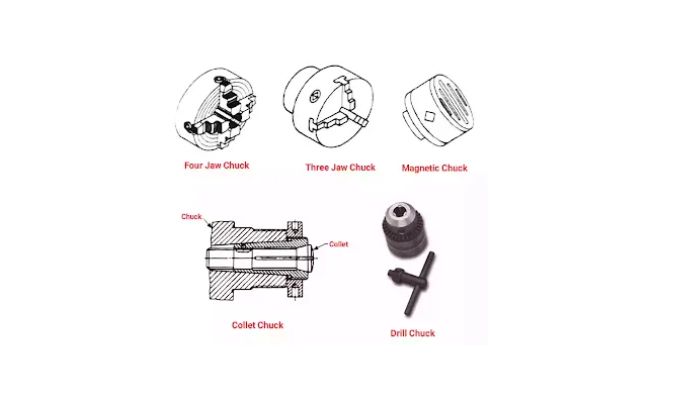
Four Jaw Chuck
It is alternatively known as an Independent Jaw Chuck, featuring four jaws that can be individually adjusted using a chuck key.
These reversible jaws have steps designed on them, providing versatility for mounting workpieces or jobs of various sizes.
This type of chuck is particularly employed for securing both regular and irregularly shaped jobs, handling heavy components, and accommodating large diameter workpieces.
Advantages of Four Jaw Chuck
- The job can be true to a precision of 0.02 mm.
- The workpieces can be set for eccentric turning.
- Larger diameter jobs can be easily held using reversible jobs.
- Irregular shaped jobs can be easily held.
- It has more gripping power.
Disadvantages of Four Jaw Chuck
- The workpieces setting is more difficult than the three jaw chuck.
- It is not suitable for mass production.
Three Jaw Chuck
It goes by the names Universal Chuck, Self-Centric Chuck, and Concentric Chuck. This chuck variant comprises three jaws that operate simultaneously, featuring distinct internal and external jaws.
Parts of Planer Machine and Their Types, Operation, Mechanism
In a three-jaw chuck should hold a round job and the hexagonal workpieces.
Advantages of Three Jaw Chuck
- In three jaw chuck, cylindrical and hexagonal workpieces can be easily set in the center.
- It is suitable for mass production.
- Setting up jobs is easy.
Magnetic Chuck
The job on this chuck is hold by magnetic power.
Magnetic chuck is suitable for mass production of thin sectioned jobs and components.
The following types of Magnetic Chuck are found
- Permanent Magnetic Chuck
- Electromagnetic Chuck
Collet Chuck
Collet chucks are primarily employed for securing jobs with a diameter of less than 25 mm.
Collets are available in sizes up to 25 mm in diameter.
The collet chuck is highly efficient, streamlining the work-holding process, and contributing to an enhanced production speed.
Combination Chuck
Typically, it is a four-jaw chuck where the jaws can be adjusted independently, similar to a four-jaw chuck, or collectively, like a three-jaw chuck.
This chuck type is employed in situations where duplicate workpieces are present.
To secure the workpieces, a self-centering socket is utilized in the chuck’s body.
Air Chuck or Hydraulically Operated Chuck
This type of chuck is employed in mass production work due to its rapid and efficient gripping capabilities.
Its mechanism incorporates a hydraulic or air cylinder positioned at the rear end of the headstock, rotating in conjunction with it.
By manipulating the valves, fluid pressure is conveyed to the cylinder.
The operation of this chuck can be either manual or automatic.
The piston’s movement is transferred to the jaws and connecting rod links, ensuring proper gripping of the workpieces.
Drill Chuck
A drill chuck is a tool-holding device utilized for securing drill bits or drills in a drilling machine.
Lathe Centers
The Center is a work-holding device in a lathe designed for supporting long jobs between the headstock and tailstock to facilitate lathe operations.
Lathe centers are typically crafted from high carbon steel, undergoing processes of hardening, tempering, and grinding.
The center that rotates along with a job in the headstock spindle’s nose is referred to as a live center.
On the other hand, the center positioned at the tailstock remains stable, earning it the designation of a dead center.
Both centers share similar characteristics in terms of texture.
It is advisable to use lubricants for dead centers, while live centers do not require lubrication.
The top angle of the corner point of the lathe center is 60°, and the center features a Morse taper shank and a tang.
Different Types of Lathe Centers
There are the following types of lathe centers:
- Ordinary Center
- Half Center
- Tipped Center
- Ball Center
- Pipe Center
- Revolving Center
- Inserted Type Center
- Self Driving Live Center
- Female Center
- Swivel ‘V’ Center
See in a figure different types of lathe centers, which are described below in detail.
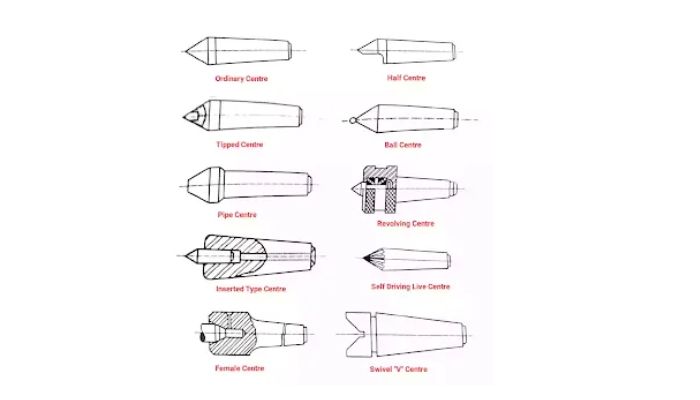
Ordinary Center
It is a common type of center that is used for simple tasks.
Half Center
The tip portion of this center is relieved by less than half.
It is used when facing the job without disturbing the setting.
Tipped Center
This wear-resistant center incorporates a tip made of carbide or hard alloy, brazed into the nose of a basic steel shank.
Ball Center
The center features a ball-shaped tip that minimizes wear and tear, making it especially suitable for executing taper turning through the offset method.
Pipe Center
Its tip is flat and It is used to support pipes, shells, and hollow-end workpieces.
Revolving Center
This non-friction center, commonly referred to as a revolving dead center, is employed in situations where large and heavy jobs need to be operated at high speeds.
Inserted Type Center
It is a saving center as only a small high speed insert is replaced.
Self Driving Live Center
This center is equipped with points cut around its periphery to provide a secure grip on the job and ensure effective driving.
It is installed on the headstock spindle and is employed when machining the entire length of a job in a single setting.
It is not suitable for use on hard jobs but is specifically designed for soft jobs.
Female Center
This center is utilized to support types of jobs where creating a countersink hole is not feasible.
Swivel ‘V’ Center
Utilizing this center involves supporting the job in its ‘V’ part and employing a drill or drill bits in the headstock spindle to bore holes across the job.
Steady Rest
A steady rest is a form of work-holding device in a lathe machine employed for securing or supporting long cylinders or thin jobs.
Surface Grinding Machine Parts and Function,Types,Uses
It is utilized to uphold and stabilize the position of the job during the turning process.
Types of Steady Rest
Often the following types of steady rests are used:
- Traveling Steady Rest
- Fixed Steady Rest
- Revolving Steady Rest
See types of steady rest in the figure, which are described below in detail.
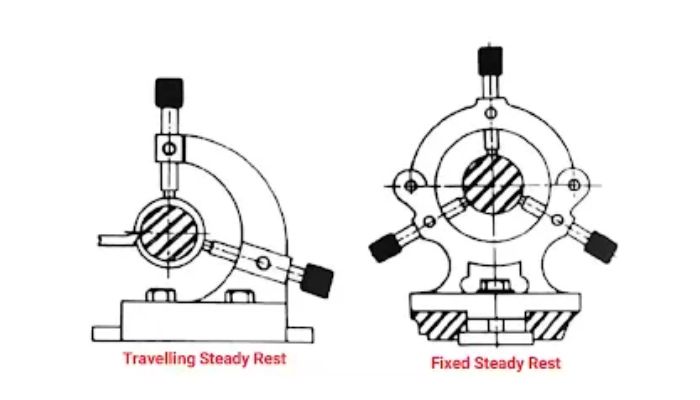
Traveling Steady Rest
Also referred to as a follower steady rest, this device is connected to a cross slide positioned on the opposite side of the cutting tool.
Featuring two adjustable jaw pieces, it operates in tandem with a carriage on the bed.
Fixed Steady Rest
The fixed steady rest can be positioned at any fixed location on the lathe bed.
It incorporates three adjustable jaw pieces, each controlled by distinct screws.
Revolving Steady Rest
The revolving steady rest resembles a fixed steady rest, with its lower part affixed to the lathe bed.
It is employed for securing square and hexagonal rods.
Lathe Carriers
The carrier or dog serves as a work-holding device in a lathe machine, utilized for securing a job when it requires fixation between the centers.
The work or job is inserted into the hole of the carrier and then securely fastened.
Types of Lathe Carriers
Often the following types of lathe carriers are used:
- Straight Tail Carrier
- Bent Tail Carrier
- Adjustable Carrier
See in the figure types of lathe carriers, which are briefly described below.
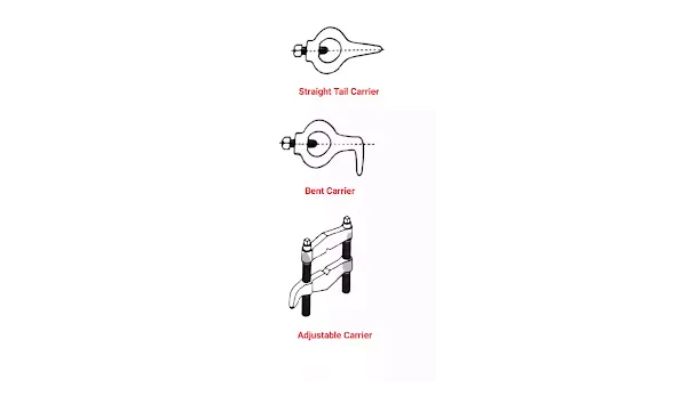
Straight Tail Carrier
The tail of this carrier is straightened and positioned against the driving pin of the catch plate, ensuring a positive drive for the job.
Bent Tail Carrier
The tail of this carrier is curved and affixed in the ‘U’ slot of the catch plate to drive the job.
Adjustable Carrier
This is a clamp-type carrier comprising a clamping plate and an adjustable screw.
Unconventional Machining Process: Types, Working, Uses
It is employed for securing small diameter jobs as well as square and rectangular-shaped rods.
Driving Plate
It is a circular plate employed during the turning of jobs between centers.
It is utilized in conjunction with a straight or bent-tail carrier to impart a positive drive to the job.
Types of Driving Plate
There are following types of driving plates are used:
- Catch Plate
- Driving Plate with Pin
- Safety Driving Plate
See in a figure different types of driving plates in a lathe machine.
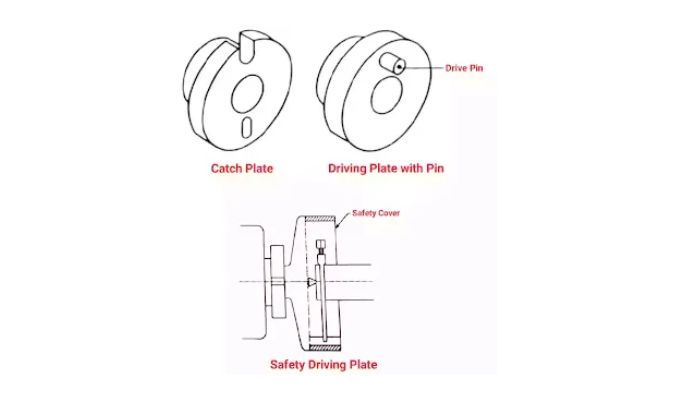
Catch Plate
This plate incorporates a ‘U’ slot and an elliptical slot where the bent tail of the lathe carrier is affixed.
This setup necessitates a shorter length for clamping.
Driving Plate with Pin
This plate features an ejector pin designed to position the straight tail of the lathe carrier.
It ensures a positive drive for the workpieces.
Safety Driving Plate
Crafted from cast iron, this driving plate shares a resemblance with a standard driving plate but includes a protective cover to shield the operator from potential injury.
Additionally, it features a stepped collar on its rear side.
Face Plate
This circular plate is employed for executing diverse turning operations on large, flat, and irregularly shaped jobs, castings, etc.
The face plate is affixed to the lathe spindle, allowing the job to be mounted on it for the purpose of turning operations.
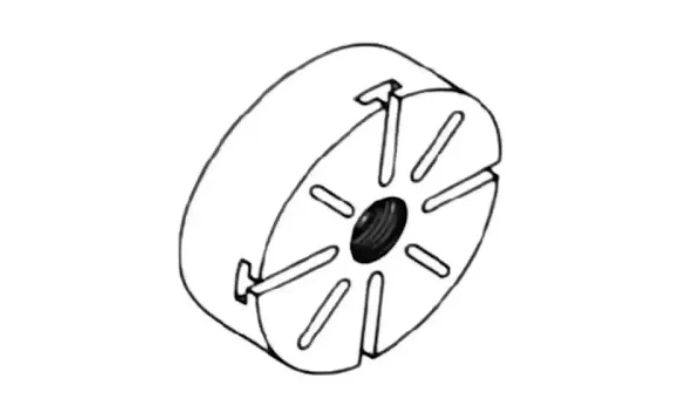
Lathe Mandrel
The lathe mandrel serves as a device for holding workpieces or jobs that have already been bored or drilled.
Frequently, the mandrel is hardened using tool steel and ground to a specified size.
It undergoes grinding with a 1:2000 taper.
Types of Lathe Mandrel
The following types of the mandrel are often used:
- Plain Mandrel
- Stepped mandrel
- Collar Mandrel
- Screwed Mandrel
- Cone Mandrel
- Gang Mandrel
- Expansion Mandrel
- Taper Shank Mandrel
Show in a figure different types of lathe mandrel, which are described below.
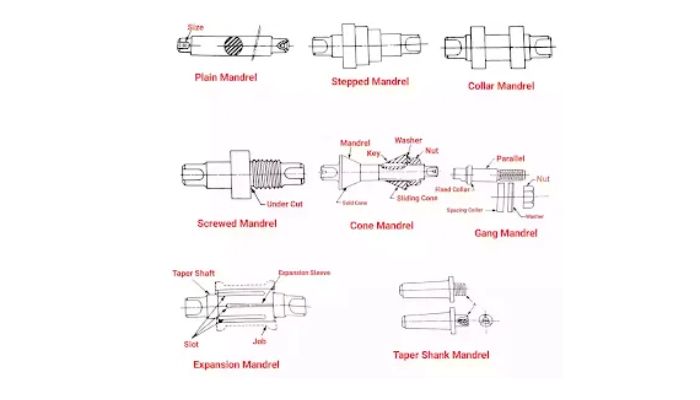
Plain Mandrel
This mandrel is commonly found with a slight taper (1:2000), facilitating proper gripping of the workpieces.
Cylindrical Grinding Machine: Working, Parts, Types, Uses
It is specifically suitable for a single-size bore.
Stepped mandrel
This mandrel has steps with different diameters.
Different diameters of workpieces can be fitted on this mandrel.
Collar Mandrel
Collars are incorporated into this mandrel, significantly reducing its overall weight.
This type of mandrel is employed for turning large diameter workpieces.
Screwed Mandrel
Threads are crafted at one end of this mandrel, and a collar is shaped on it.
This mandrel is utilized for securing workpieces with internal threads.
Cone Mandrel
This mandrel is employed for gripping workpieces with varying hole diameters.
Featuring a solid cone on one end and a sliding cone with threads on the other side, the workpieces are secured between these two cones. The sliding cone is adjusted, and the nut is tightened to maintain the workpieces in the desired position.
Gang Mandrel
This mandrel possesses a parallel body, featuring a fixed collar at one end and a spacing collar at the other end.
Both ends are threaded, with a washer and nut affixed to them.
Multiple identical workpieces can be positioned between the fixed and spacing collars on this mandrel, and the nut is securely tightened to secure them in place.
Expansion Mandrel
This mandrel comprises a solid core and an inclined sleeve.
It proves particularly advantageous for workpieces with diameters differing from the standard size.
This type of mandrel is also highly beneficial for use in repair workshops.
Taper Shank Mandrel
The taper shank of this mandrel is designed to fit into the headstock spindle.
So, in this discussion, I covered work holding devices in a lathe machine, which are considered lathe machine accessories. The detailed functions of these holding tools have also been explained.
I hope you found this topic enjoyable. For any queries, feel free to reach out to me via email or the contact us page.
Thank You.
I’ve recently started a web site, the info you offer on this website has helped me tremendously. Thank you for all of your time & work.